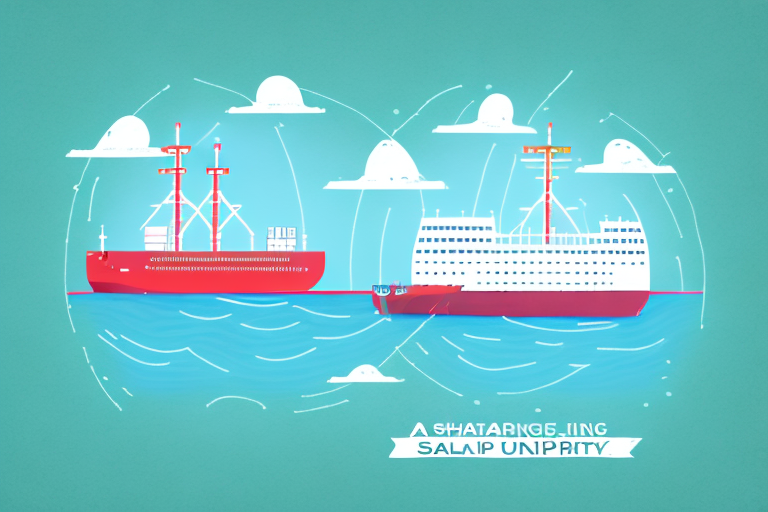Understanding the Benefits of Blank Sailing in Supply Chain Management
Optimizing efficiency is paramount in supply chain management. One strategic approach that has garnered attention in recent years is blank sailing. This article delves into the concept of blank sailing, its operational mechanics, associated benefits and challenges, and examines case studies of companies that have effectively integrated this strategy into their supply chain management. Additionally, we offer best practices for successful implementation, supported by data and insights from reputable sources.
What is Blank Sailing and How Does it Work?
Blank sailing occurs when shipping companies cancel a scheduled voyage to align supply with demand. This strategy aims to mitigate excess capacity in the shipping market, thereby optimizing transportation costs. By eliminating underutilized voyages, shipping firms can enhance operational efficiency and reduce unnecessary expenditures.
Blank sailing involves the strategic cancellation of select voyages over a specific period, typically spanning one to two weeks. The objective is to reduce surplus capacity without compromising customer service levels. Effective implementation necessitates meticulous planning, transparent communication, and collaboration between shipping companies and their clients.
This practice is prevalent in the shipping industry, particularly during periods of diminished demand or unforeseen disruptions such as natural disasters or pandemics. For instance, during the COVID-19 pandemic, many shipping companies employed blank sailing to stabilize freight rates and prevent market oversaturation. However, it can also adversely affect shippers dependent on consistent transportation services, highlighting the need for clear communication and alternative solutions.
The Role of Blank Sailing in Supply Chain Optimization
Blank sailing is instrumental in optimizing supply chain management by curbing excess capacity, thereby reducing transportation costs and enhancing profitability. This cost-efficiency can translate to more competitive pricing for customers and elevated service levels.
Preventing overcapacity is another critical role of blank sailing. An oversupplied shipping market can drive freight rates down, prompting a competitive race to the lowest prices. By balancing supply with market demand, blank sailing helps maintain stable shipping rates, benefiting both shipping companies and their clients.
Moreover, blank sailing serves as a strategic tool for managing unexpected supply chain disruptions. For example, if a port closure occurs due to a natural disaster or labor strike, blank sailing can be deployed to mitigate congestion and delays, ensuring timely delivery of goods. According to the Logistics Bureau, such proactive measures are essential for minimizing the ripple effects of disruptions on the supply chain.
Top 5 Benefits of Blank Sailing for Supply Chain Management
- Cost Savings: By eliminating excess capacity, blank sailing ensures that each voyage operates at full capacity, thereby reducing overall shipping costs.
- Improved Customer Service: Optimized vessel usage prevents overcrowding, facilitating more efficient and timely deliveries.
- Increased Flexibility: Blank sailing allows shipping companies to adjust their services in response to fluctuating market conditions.
- Enhanced Capacity Planning: Analyzing blank sailing data provides insights into market trends, aiding in more accurate future capacity planning.
- Competitive Advantage: Effective blank sailing strategies enable shipping companies to differentiate themselves, leading to increased market share and profitability.
Additionally, blank sailing contributes to environmental sustainability. By optimizing vessel usage, shipping companies can reduce their carbon footprint, aligning with global sustainability goals. This environmental stewardship not only benefits the planet but also enhances brand reputation and fosters customer loyalty, as consumers increasingly prioritize eco-friendly practices.
Case Studies: How Companies Utilize Blank Sailing to Improve their Supply Chain Performance
Maersk, the world's largest container shipping company, effectively utilizes blank sailing to balance supply and demand across different seasons. During periods of low demand, Maersk strategically cancels sailings to reduce operational costs, ensuring that their vessels operate at full capacity during peak times. According to Maersk’s 2023 report, this approach has significantly enhanced their cost-efficiency and service reliability.
Hyundai Merchant Marine, a leading Korean shipping company, employs a strategy known as "smart blanking." This involves the selective cancellation of sailings based on historical data and projected market trends. Through this data-driven approach, Hyundai has improved service levels and reduced costs, resulting in heightened customer satisfaction and profitability, as highlighted in their 2023 sustainability report.
CMA CGM, a prominent French container transportation and shipping company, implements the "Ocean Alliance Day 3 Product" strategy. This entails blank sailing on specific routes to optimize vessel capacity and lower costs. CMA CGM’s strategy has not only improved schedule reliability but also reduced their carbon footprint by decreasing the number of vessels required for the same cargo volume, as detailed in their 2023 environmental report.
Common Misconceptions About Blank Sailing and the Truth Behind Them
A prevalent misconception is that blank sailing primarily serves as a cost-cutting mechanism that undermines customer service. While reducing excess capacity is a key objective, when implemented effectively, blank sailing can enhance service levels by ensuring voyages run at optimal capacity, leading to more efficient deliveries and higher customer satisfaction.
Another misunderstanding is the belief that blank sailing is a one-size-fits-all solution applicable to any shipping strategy. In reality, blank sailing must be tailored to each company’s specific needs and market conditions. Factors such as market demand, customer expectations, and operational capacities must be considered to devise an effective blank sailing strategy.
Furthermore, blank sailing is not a novel concept; it has been a staple in the shipping industry for decades as a means to manage capacity and sustain profitability. The modern emphasis on sustainability has, however, renewed its relevance, positioning blank sailing as a tool for reducing carbon emissions and promoting environmentally responsible shipping practices. By decreasing the number of active vessels, shipping companies can significantly lower their environmental impact, aligning with global sustainability standards.
The Future of Blank Sailing in the Ever-Evolving Supply Chain Industry
The role of blank sailing is projected to expand within the supply chain industry as competition intensifies and the focus on optimization and sustainability grows. Future trends suggest a move towards more sophisticated, data-driven blank sailing strategies that enhance accuracy and yield greater cost savings. For instance, the integration of artificial intelligence and machine learning can revolutionize blank sailing schedules by analyzing vast datasets on shipping routes, cargo volumes, and market conditions to predict optimal sailing cancellations with higher precision.
Advancements in technologies such as blockchain could further enhance supply chain transparency and efficiency, making blank sailing an even more viable option for streamlining operations. According to a Supply Chain Digital report, blockchain technology offers improved traceability and real-time data sharing, which can facilitate more responsive and adaptive blank sailing strategies.
Challenges Faced by Companies Implementing Blank Sailing and How to Overcome Them
Effective Communication: One of the primary challenges is maintaining transparent communication with customers. Concerns about service disruptions are common, necessitating proactive communication to reassure customers and provide alternative solutions. Implementing a robust communication strategy can mitigate these concerns and foster trust.
Accurate Demand Prediction: Precisely forecasting market demand to determine the optimal number of sailings to cancel is complex. Companies must invest in advanced data analytics tools and collaborate closely with customers to enhance predictive accuracy. Leveraging historical data and real-time market insights can improve decision-making processes.
Revenue Loss Risks: Cancelling sailings may lead to potential revenue losses, particularly for smaller companies with limited resources. To counter this, companies can explore alternative revenue streams, such as offering value-added services or forming partnerships to share resources and reduce costs.
Key Factors to Consider Before Implementing Blank Sailing in Your Supply Chain Strategy
- Data Analysis: Analyze historical data and current market trends to identify the optimal number of sailings to cancel.
- Customer Service Impact: Evaluate how blank sailing will affect customer service levels and develop strategies to maintain high service standards.
- Proactive Communication: Engage in transparent communication with customers to educate them about the benefits and methodologies of blank sailing.
- Advanced Analytics: Invest in sophisticated data analytics tools to enhance demand forecasting and capacity planning.
- Customization: Tailor the blank sailing strategy to align with your company’s unique needs and the specific market conditions.
- Supplier Coordination: Assess the potential impact on suppliers and collaborate closely to ensure they can adapt to changes in the supply chain strategy.
- Continuous Monitoring: Regularly monitor the effectiveness of the blank sailing strategy and make necessary adjustments to optimize performance.
Best Practices for Successful Implementation of Blank Sailing in Your Supply Chain Management Plan
- Collaborate with Customers: Engage with customers to understand their needs and preferences, ensuring that blank sailing decisions align with their expectations.
- Utilize Advanced Analytics: Employ data-driven tools to accurately forecast market demand and manage capacity planning effectively.
- Develop a Communication Strategy: Create a proactive communication plan to inform customers about the benefits and implementation strategies of blank sailing.
- Customize Your Strategy: Adapt the blank sailing approach to fit your company’s unique operational requirements and market dynamics.
- Continuous Evaluation: Regularly assess and refine your blank sailing strategy to enhance efficiency and profitability continuously.
Blank sailing represents a potent strategy for optimizing supply chain management and boosting profitability. By meticulously analyzing market demand, fostering customer collaboration, and leveraging advanced data analytics, companies can implement blank sailing effectively to minimize excess capacity, enhance operational efficiency, and distinguish themselves in a competitive market. As the supply chain industry continues to evolve, blank sailing is poised to become an increasingly vital tool for companies striving to optimize performance and achieve long-term success.
However, it is crucial to consider the potential impact on customer satisfaction. While blank sailing can drive cost reductions and operational efficiencies, it may also result in longer lead times and delivery delays. To mitigate these risks, companies should adopt a customer-centric approach by closely collaborating with customers to understand their needs and preferences and by developing contingency plans to address unexpected disruptions. Balancing cost savings with customer satisfaction is essential for achieving sustainable success in supply chain management.






















